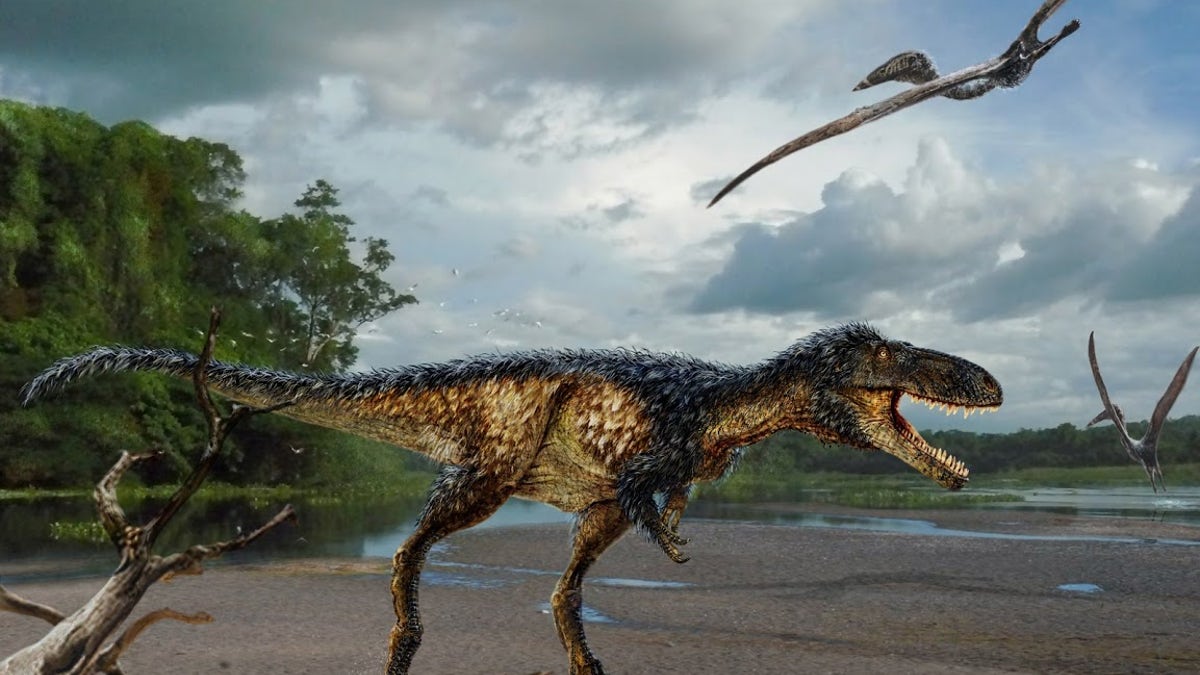
Artist rendering of the newly discovered dinosaur, Timurlengia euotica. (Todd Marshall)
A horse-sized cousin of Tyrannosaurus rex discovered in Uzbekistan is giving scientists a better sense of how small body dinosaurs evolved to become dominant predator towards the end of the Mesozoic.
Timurlengia euotica, which roamed the Earth around 90 million years ago, is also helping fill in a “frustrating 20 million year gap” in the fossil record of tyrannosaurs - the group includes Tyrannosaurus rex - during the Mid-Cretaceous, Steve Brusatte, of the University of Edinburgh’s School of GeoSciences, who led the team that made the discovery, told FoxNews.com
“The ancestors of T. rex would have looked a whole lot like Timurlengia, a horse-sized hunter with a big brain and keen hearing that would put us to shame,” Brusatte, whose findings appeared in Proceedings of the National Academy of Sciences, said. “Only after these ancestral tyrannosaurs evolved their clever brains and sharp senses did they grow into the colossal sizes of T. rex. Tyrannosaurs had to get smart before they got big.”
Related: Dinosaur was giving 'the finger' due to bone deformity
The remains were discovered in northern Uzbekistan’s Kyzylkum Desert, a region that has provided one of the world’s best records of Mid-Cretaceous dinosaurs. The team, which also included Alexander Averianov and Hans–Dieter Sues, found lots of bits and pieces of Tyrannosaur skeletons.
However, it was the back part of a skull that told them they had a new species of tyrannosaur on their hands.
“[The back end of the skull] turned out to be the Rosetta stone,” Brusatte said. “It's a very complex part of the anatomy that we can easily compare to a lot of other dinosaurs, and that's what told us we definitely had a tyrannosaur, that it was a new species, and that it was only about the size of a horse.”
With the back end of the skull being the region that contained the brain, ear, sinus, and cranial nerves, Brusatte and his team used a CT scanner to dig deeper.
“When we did so, we realized that the brain and ear were very, very similar to those of Tyrannosaurus rex and other big tyrannosaurs, only this new species was much smaller,” Brusatte explained. “This tells us that the large, distinctively shaped brains, and particularly the unique inner ear (with a big cochlea, which enables better hearing of low frequency sounds) of the big tyrannosaurs like T. rex actually evolved earlier in time, in their smaller relatives.”
Related: Mini T. Rex: 'Welsh Dragon' may be earliest Jurassic dinosaur
It was previously believed that T. Rex’s intelligence and keen senses of hearing, smell and sight evolved as the dinosaur grew to its large, iconic size. But the discovery of Timerlengia shows this occurred much earlier.
“These small ancestors were then really well–equipped to take over the large predator role when the opportunity presented itself when other large predatory dinosaurs– like allosaurs– went extinct,” Brusatte said.
Despite its relatively small size, Timerlengia would still have been a fearsome predator and relatively fast due to its long legs.
“Timurlengia was a nimble pursuit hunter with slender, blade-like teeth suitable for slicing through meat,” Sues, of the National Museum of Natural History, Smithsonian Institution and an author on the study said in a statement. “It probably preyed on the various large plant-eaters, especially early duck-billed dinosaurs, which shared its world.”
Related: Fossil of duck-billed dinosaur found along Alabama creek
The tyrannosaur's huge size, appears to have come later.
Appearing about 170 million years ago, it would grow from the size of a human to a predator weighing around 8 tons. The fact that Timurlengia was only 550 pounds would suggest that tyrannosaurs only grew big toward the tail end of its evolutionary history.
